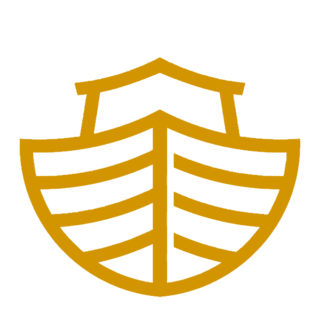A Uniform Resource Identifier (URI) is a unique sequence of characters that identifies an abstract or physical resource, such as resources on a webpage, mail address, phone number, books, real-world objects such as people and places, concepts. URIs are used to identify anything described using the Resource Description Framework (RDF), for example, concepts that are part of an ontology defined using the Web Ontology Language (OWL), and people who are described using the Friend of a Friend vocabulary would each have an individual URI.

In the Internet, a domain name is a string that identifies a realm of administrative autonomy, authority or control. Domain names are often used to identify services provided through the Internet, such as websites, email services and more. Domain names are used in various networking contexts and for application-specific naming and addressing purposes. In general, a domain name identifies a network domain or an Internet Protocol (IP) resource, such as a personal computer used to access the Internet, or a server computer.
Telephone number mapping is a system of unifying the international telephone number system of the public switched telephone network with the Internet addressing and identification name spaces. Internationally, telephone numbers are systematically organized by the E.164 standard, while the Internet uses the Domain Name System (DNS) for linking domain names to IP addresses and other resource information. Telephone number mapping systems provide facilities to determine applicable Internet communications servers responsible for servicing a given telephone number using DNS queries.
A Uniform Resource Name (URN) is a Uniform Resource Identifier (URI) that uses the urn scheme. URNs are globally unique persistent identifiers assigned within defined namespaces so they will be available for a long period of time, even after the resource which they identify ceases to exist or becomes unavailable. URNs cannot be used to directly locate an item and need not be resolvable, as they are simply templates that another parser may use to find an item.
A path is a string of characters used to uniquely identify a location in a directory structure. It is composed by following the directory tree hierarchy in which components, separated by a delimiting character, represent each directory. The delimiting character is most commonly the slash ("/"), the backslash character ("\"), or colon (":"), though some operating systems may use a different delimiter. Paths are used extensively in computer science to represent the directory/file relationships common in modern operating systems and are essential in the construction of Uniform Resource Locators (URLs). Resources can be represented by either absolute or relative paths.

A digital object identifier (DOI) is a persistent identifier or handle used to uniquely identify various objects, standardized by the International Organization for Standardization (ISO). DOIs are an implementation of the Handle System; they also fit within the URI system. They are widely used to identify academic, professional, and government information, such as journal articles, research reports, data sets, and official publications.
A permalink or permanent link is a URL that is intended to remain unchanged for many years into the future, yielding a hyperlink that is less susceptible to link rot. Permalinks are often rendered simply, that is, as clean URLs, to be easier to type and remember. Most modern blogging and content-syndication software systems support such links. Sometimes URL shortening is used to create them.
I-names are one form of an XRI — an OASIS open standard for digital identifiers designed for sharing resources and data across domains and applications. I-names are human readable XRIs intended to be as easy as possible for people to remember and use. For example, a personal i-name could be =Mary or =Mary.Jones. An organizational i-name could be @Acme or @Acme.Corporation.
A persistent uniform resource locator (PURL) is a uniform resource locator (URL) that is used to redirect to the location of the requested web resource. PURLs redirect HTTP clients using HTTP status codes.
A Name Authority Pointer (NAPTR) is a type of resource record in the Domain Name System of the Internet.
A web resource is any identifiable resource present on or connected to the World Wide Web. Resources are identified using Uniform Resource Identifiers (URIs). In the Semantic Web, web resources and their semantic properties are described using the Resource Description Framework (RDF).
Life Science Identifiers are a way to name and locate pieces of information on the web. Essentially, an LSID is a unique identifier for some data, and the LSID protocol specifies a standard way to locate the data. They are a little like DOIs used by many publishers.
Clean URLs are web addresses or Uniform Resource Locator (URLs) intended to improve the usability and accessibility of a website, web application, or web service by being immediately and intuitively meaningful to non-expert users. Such URL schemes tend to reflect the conceptual structure of a collection of information and decouple the user interface from a server's internal representation of information. Other reasons for using clean URLs include search engine optimization (SEO), conforming to the representational state transfer (REST) style of software architecture, and ensuring that individual web resources remain consistently at the same URL. This makes the World Wide Web a more stable and useful system, and allows more durable and reliable bookmarking of web resources.

Michael Mealling is co-founder of Pipefish Inc, and was the cofounder, Chief Financial Officer (CFO) and Vice President of Business Development of Masten Space Systems, CEO of Refactored Networks, long time participant within the IETF, a Space Frontier Foundation Advocate, and a former Director of the Moon Society. He operates a blog site called Rocketforge and has been interviewed twice on The Space Show and twice on SpaceVidcast.
In programming, a file uniform resource identifier (URI) scheme is a specific format of URI, used to specifically identify a file on a host computer. While URIs can be used to identify anything, there is specific syntax associated with identifying files.
The Handle System is the Corporation for National Research Initiatives's proprietary registry assigning persistent identifiers, or handles, to information resources, and for resolving "those handles into the information necessary to locate, access, and otherwise make use of the resources".

An Archival Resource Key (ARK) is a multi-purpose URL suited to being a persistent identifier for information objects of any type. It is widely used by libraries, data centers, archives, museums, publishers, and government agencies to provide reliable references to scholarly, scientific, and cultural objects. In 2019 it was registered as a Uniform Resource Identifier (URI).
An Extensible Resource Identifier (XRI) is a scheme and resolution protocol for abstract identifiers compatible with Uniform Resource Identifiers (URI) and Internationalized Resource Identifiers (IRI), developed by the XRI Technical Committee at OASIS. The goal of XRI was a standard syntax and discovery format for abstract, structured identifiers that are domain-, location-, application-, and transport-independent, so they can be shared across any number of domains, directories, and interaction protocols.
Identifiers.org is a project providing stable and perennial identifiers for data records used in the Life Sciences. The identifiers are provided in the form of Uniform Resource Identifiers (URIs). Identifiers.org is also a resolving system, that relies on collections listed in the MIRIAM Registry to provide direct access to different instances of the identified records.
A uniform resource locator (URL), colloquially known as an address on the Web, is a reference to a resource that specifies its location on a computer network and a mechanism for retrieving it. A URL is a specific type of Uniform Resource Identifier (URI), although many people use the two terms interchangeably. URLs occur most commonly to reference web pages (HTTP/HTTPS) but are also used for file transfer (FTP), email (mailto), database access (JDBC), and many other applications.



